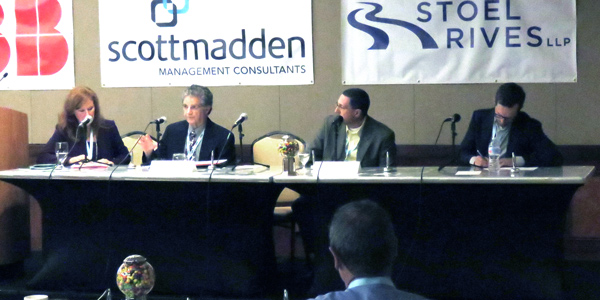By Jason Fordney
SAN DIEGO — The fate of the West’s coal-fired power was already sealed prior to EPA’s announcement that it will seek to repeal the Clean Power Plan, a panel of industry participants said last week at Infocast’s Transmission Summit West.
But those panelists also agreed there has not been adequate consideration of the impact of coal retirements on the region’s grid. The Trump administration argued that former President Barack Obama’s call for switching to more natural gas and renewable generation caused the agency to exceed its authority. (See EPA to Announce Clean Power Plan Repeal.)
ITC Grid Development’s Ron Belval said that while federal regulation affects coal-fired power, “I think it is going to be an economic decision; the wheels have already been set in motion” by low gas prices and more penetration of renewables. There might be some extension of the life of existing plants, but they will still be retired, he said.
The Western transmission network was designed for a traditional resource mix serving certain load centers, including areas that are served by coal, gas and nuclear, Belval said. The retirements of coal-fired plants will dramatically change how the system will be utilized, but the characteristics of the new system have not been identified.
Belval noted that there are also the requirements of California’s “duck curve” to consider. It is unclear what the mix of new resources will be or exactly where they will be deployed, he said, and the grid has needs in terms of frequency response and voltage regulation.
By 2025, about 5,000 MW of coal-fired capacity is scheduled for retirement in the West — basically all the large plants, according to Keegan Moyer, a principal with Energy Strategies.
“That is most of it; there is not that much more after that,” he said, adding that there is a not a “cookie-cutter” strategy for replacing those resources.
The retirements will free up transmission capacity that could be used by other resources, creating opportunities for new entrants, panelists said.
The transmission system is designed around natural gas plants that have also served to balance renewables and can quickly ramp up, and operators also are used to certain conditions, Belval said. “I suppose you could replace the gas resources, but I don’t know what those would be,” he said, noting that other resources are “not tried and true.”
“You have got to replace those with something that you know works,” and those resources need to be modeled in the operational time frame, he said.
Brian Cole, director of engineering at Arizona Public Service, said that at his utility, “the schedule for shutting down the older [coal] plants had already begun to be put in place. The Clean Power Plan just helped cement that and make that happen.” System operators are seeing the impact of renewables at the transmission and distribution levels, he said.
“We are trying to get our arms around it,” he said, adding that the removal of baseload generation also requires new ramping capabilities.
The CPP’s repeal effort has been accompanied by Energy Secretary Rick Perry’s recent directive that FERC ensure cost recovery for at-risk coal and nuclear generation in organized markets, representing an additional seismic shift in direction at the federal level. (See Perry Orders FERC Rescue of Nukes, Coal.) But panel participants indicated that the proposals are a long way from causing a surge in demand for coal-fired energy resources in Western states.





